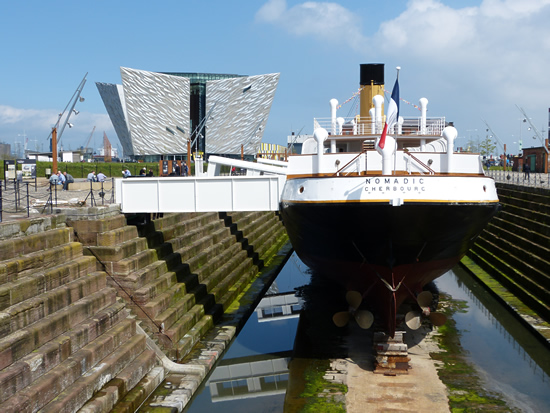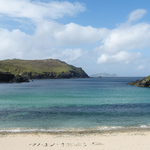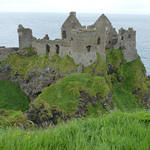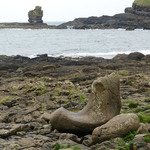On my recent visit to Belfast, we spent a day exploring the Titanic Quarter of the city. There are several sights to see here, including the SS Nomadic, the Titanic museum, and the Titanic Dry Dock and Pump House. Additionally, we walked past Titanic Studios, where the television series Game of Thrones is being filmed, and we caught views of the two massive yellow cranes nicknamed Samson and Goliath. We arrived straight from Belfast City airport and dropped our luggage off at the hotel on the far side of the city centre before walking to the Titanic Quarter and exploring this area of Belfast.

The Titanic Museum and SS Nomadic in Hamilton Dock
One of our stops was to Titanic Belfast, a museum dedicated to the RMS Titanic. The museum opened in 2012 and is a new addition to Belfast and explains the story of the Titanic and shipbuilding in Belfast. The exterior of the building is meant to mimic a ship, and it is placed between the slipways used by the Titanic and its sister ship the Olympic, and others refer to it as "The Iceburg". The height of the building mimics the Titanic's height.

Titanic Belfast
The bronze figure (pictured below) in front of the museum is meant to represent the figures that were placed on the front of ships.

Titanic Belfast
Inside the museum is a museum is an interactive ride through a fabricated shipyard that explains how the ships were built. There's also stories about some of the notable people aboard the Titanic when it sank. There's also a viewing gallery where you can see video of the wreckage, and just below this is a representation of how the Titanic currently looks on the bed of the sea, but there were some technical difficulties with this when we visited.

Viewing gallery (video of the Titanic wreckage)
There are also replica rooms for first, second, and third classes in the museum as well as the White Star Line cutlery and plates that would have been used in the Titanic. There's also a first class menu of the final meal that they had the evening that the Titanic sank. The grand staircase used in the 1997 Titanic film is also in the museum, but sadly general visitors cannot access this; it is only accessible with booked afternoon tea.

Menu, replica dishes and a first class cabin on the Titanic
Just behind the new Titanic museum is the Olympic Slipway, where the RMS Olympic was built alongside RMS Titanic. This whole area (known as the Titanic Quarter today) used to be busy with ship-building.
At least 4,000 men were involved in building RMS Olympic. Three White Star line ships were built here: Olympic, Titanic and Britannic. Olympic was the first of the three. The Olympic was also a luxurious ship and contained a swimming pool, Turkish spa, a palm garden, and several different first class cabin decor styles.
We also visited RMS Titanic's little sister ship and the only surviving White Star Line ship, SS Nomadic. The SS Nomadic was based in Cherboug, France. It was used to ferry passengers from the harbour to cruise ships (like RMS Titanic) that were too large to come into the harbour. The ship was used to ferry passengers, luggage, and other items to the Titanic when it stopped to collect passengers at Cherbourg before heading off to its fateful voyage to America. (It also stopped in Queenstown, Ireland; Queenstown cannot be found on a modern map as it has changed its named to Cobh.) One of the famous passengers that boarded this ship for the Titanic in Cherbough was Molly Brown.

SS Nomadic
We had a guided tour of the ship and were told that the different classes never mingled in that day. First class passengers would never see third class, and even the third class area was considered grand for the time. First class used expensive floor tiles, panel decorations, and a grander staircase.

First class passenger area

First class bar
Considering this ship was passed around and a restaurant and a casino at one point, it is amazing that it has survived as much as it has. They also had done a great job of restoring it and souring any bits that were missing from the original suppliers, such as the windows. The rennovation had taken awhile, and there was an exhibit on this, and the ship only opened to the public last May.

SS Nomadic
The decks were also separated for each class of people; we were told on the tour that different classes just did not mingle in those days. And the passengers would never see the crew working below the decks. We went up onto the deck and saw the wheel and Titanic Belfast museum.

On board the SS. Nomadic with Titanic Belfast in the background
SS Nomadic is moored in a dry dock, Hamilton Dock. It is near to Titanic Belfast museum. The dry dock's gate (known as a caisson) has been kept and detached and is also located in this dry dock and in front of the SS Nomadic. This was a gate that closed off the dry dock. It is shaped like a ship's hull and is hollow inside so that water can be pumped out of the dock once sealed or drawn back in.
We also went to see Titanic Pump House and Dry Docks, which is located about a fifteen minute walk from Titanic Belfast, and this is where we walked past Titanic Studios where Game of Thrones is partially filmed. The real name of this dock is Thompson Graving Dock, but the Titanic used this dry dock, and the name of the famous ship is used to publicise it. Visitors can imagine the scale of the Titanic by looking at the scale of the dry dock.

Titanic Pump House and Dry Dock
The Thompson Graving Dock was the largest dock in the world in 1911. The length of the dry dock is over 850 feet, and the Titanic and other large cruise ships used this dry dock when they were being fitted out. The pump house could drain the dock (23 million gallons of water) in about 100 minutes. The first ship to use the dry dock was the Olympic.

Titanic Pump House
We took a tour of the the Pump House, which is Victorian in architecture, and watched the video shown inside it to understand how the Pump House works. The video also showed scenes of Titanic in the dock.

Pump House

Pump House
Thompson Graving Dry Docks would have been very busy, and when we walked around the docks, we could hear 'sounds' of an audio recording coming from the dock to try to get a feeling of what it would be like to be there when the docks were a working place.
Belfast was the fastest-growing British city from 1821 to 1901, and the city's population grew three times larger than it was to over 21,000. Linen manufacturing and ship-building were popular industries. In fact, the River Lagan's course was straightened in the 1840s, and this increased ship-building.
The iron keel blocks that the ships would rest on while in the dry dock remain to this day and are on display. There was a sign next to them, and one block would weigh as much as three cars.

Thompson Graving Dock
There is another dock near to Thompson Graving Dock. It is known as Alexandra Graving dock. Inside this dock is another ship, the first World War cruiser HMS Caroline. It is the second oldest commissioned warship in the Royal Navy; the first is HMS Victory. She was the fastest ship ever built; it took 9 months to build. Most of her time at war was spent in the North Sea and Scapa Flow (Orkney islands) where she was in the Battle of Jutland and is the only surviving ship.

HMS Caroline
Have you visited Belfast and the Titanic Quarter? Let me know what you thought of it, and what was your favourite attraction?
Follow my blog with Bloglovin


Leave a comment